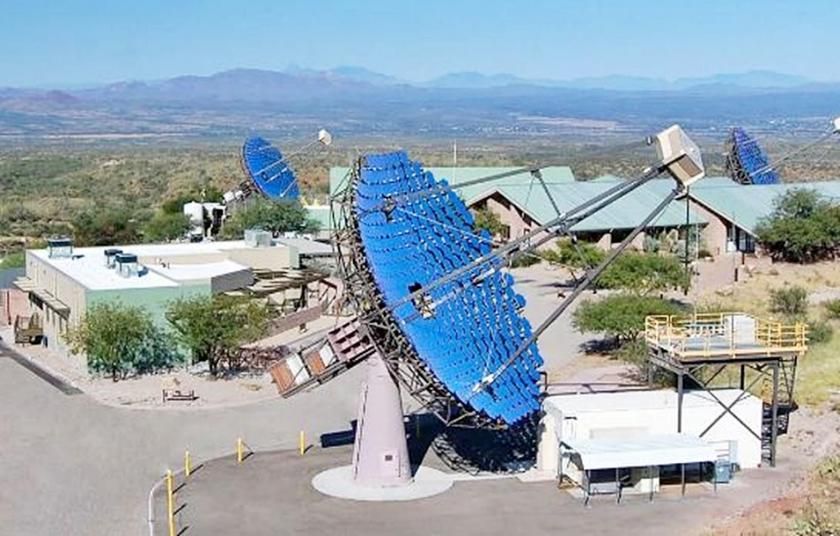Chinese Telescope Now Open to Foreign Scientists
Article by Abhijnan Rej April 3, 2021 (thediplomat.com)
• China’s Five-hundred-meter Aperture Spherical Radio Telescope (or ‘FAST’, pictured above) will now be available for use by foreign scientists, reported Chinese state media. “All foreign applications will be evaluated, and the results will be announced on July 20. Observations by international users will begin in August.”
• China’s Xinhua news agency quoted the telescope’s chief engineer as saying that 10 percent of observation time would be allocated to foreign scientists in the instrument’s first year of operations. “The project will contribute Chinese wisdom to the construction of a community with a shared future for humanity, and strive to promote international sci-tech development and the progress of human civilization.”
• FAST, located in China’s Guizhou province, is the world’s largest single-dish radio telescope and became fully operational January last year. While the telescope’s scientific uses are vast, its potential use to discover extraterrestrial intelligence (ETI) that has attracted considerable attention.
• In October 2016, the privately-funded Breakthrough Listen initiative announced that researchers using FAST will collaborate with those using the Green Bank Telescope in (West Virginia) USA and the Parkes Observatory in NSW Australia to “exchange observing plans, search methods and data” in its search for extraterrestrial intelligence.
• “Are we alone?’ is a question that unites us as a planet,” said Yuri Milner, the Russian billionaire financing the Breakthrough Initiatives. “And the quest to answer it should take place at a planetary level too. With this agreement, we are now searching for cosmic companions with three of the world’s biggest telescopes across three continents.”
• Milner drew considerable political attention amid allegations of Russian interference in the 2016 US presidential election when Milner made substantial investments in Facebook and Twitter on behalf of two Russian state entities. Milner also held stakes in a company co-owned with Jared Kushner, former White House advisor and son-in-law of Donald Trump.
• In September 2019, Maura McLaughlin, a radio astronomer at West Virginia University who studies extra-galactic pulsars, said she was “super excited to be able to use the (FAST) telescope.” However, with the deterioration of China-U.S. relations, American scientists have come under considerable scrutiny amid allegations that they are – wittingly or not – being used by the Chinese Communist Party for technical and scientific espionage and intellectual property theft. The arrest of a Massachusetts Institute of Technology (MIT) engineering professor in January on charges that he failed to adequately disclose his professional and financial ties with China added to an increasingly long list of experienced scientists who have been pursued by the US Department of Justice for their China links.
 Chinese state media reported earlier this week that China’s Five-hundred-meter Aperture
Chinese state media reported earlier this week that China’s Five-hundred-meter Aperture Spherical Radio Telescope (FAST) will now be available for use by foreign scientists. According to Xinhua, based on a statement by the Chinese Academy of Sciences’ National Astronomical Observatories of China (NAOC), “All foreign applications will be evaluated, and the results will be announced on July 20. Observations by international users will begin in August.” This announcement confirms a January NAOC announcement that FAST would be open to astronomers around the world from April 1.
Spherical Radio Telescope (FAST) will now be available for use by foreign scientists. According to Xinhua, based on a statement by the Chinese Academy of Sciences’ National Astronomical Observatories of China (NAOC), “All foreign applications will be evaluated, and the results will be announced on July 20. Observations by international users will begin in August.” This announcement confirms a January NAOC announcement that FAST would be open to astronomers around the world from April 1.

“The project will contribute Chinese wisdom to the construction of a community with a shared future for humanity, and strive to promote international sci-tech development and the progress of human civilization,” Xinhua quoted the statement as saying.

A separate January Xinhua story on FAST had quoted the telescope’s chief engineer as saying that 10 percent of observation time would be allocated to foreign scientists in the instrument’s first year of operations.
FAST, located in China’s Guizhou province, is the world’s largest single-dish radio telescope and became fully operational January last year. While the telescope’s scientific uses are vast – and the instrument had already been used to discover 100 new pulsars (fast-spinning dead stars that emit radio waves) in its test phase — it is its potential use to discover extraterrestrial intelligence (ETI) that has attracted considerable attention, including from geopolitical analysts given to (farfetched) scenario planning.
In October 2016, NAOC and the privately-funded Breakthrough Listen initiative – which funds projects for astronomers to use radio telescopes around the world to search for ETI – announced their collaboration at a ceremony in Beijing. According to a Breakthrough Initiatives statement on the occasion, researchers using FAST will collaborate with those using the Green Bank Telescope in the U.S. and the Parkes Observatory in Australia to “exchange observing plans, search methods and data.”
FAIR USE NOTICE: This page contains copyrighted material the use of which has not been specifically authorized by the copyright owner. ExoNews.org distributes this material for the purpose of news reporting, educational research, comment and criticism, constituting Fair Use under 17 U.S.C § 107. Please contact the Editor at ExoNews with any copyright issue.


 On Dec. 18, the world learned that Breakthrough Listen, a privately funded search for extraterrestrial
On Dec. 18, the world learned that Breakthrough Listen, a privately funded search for extraterrestrial




















